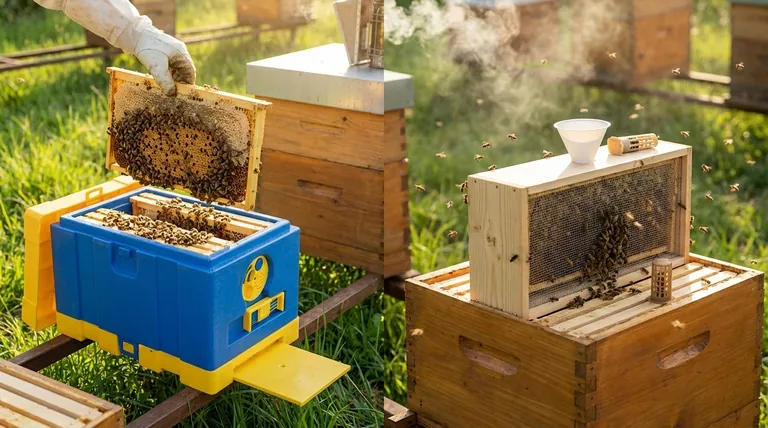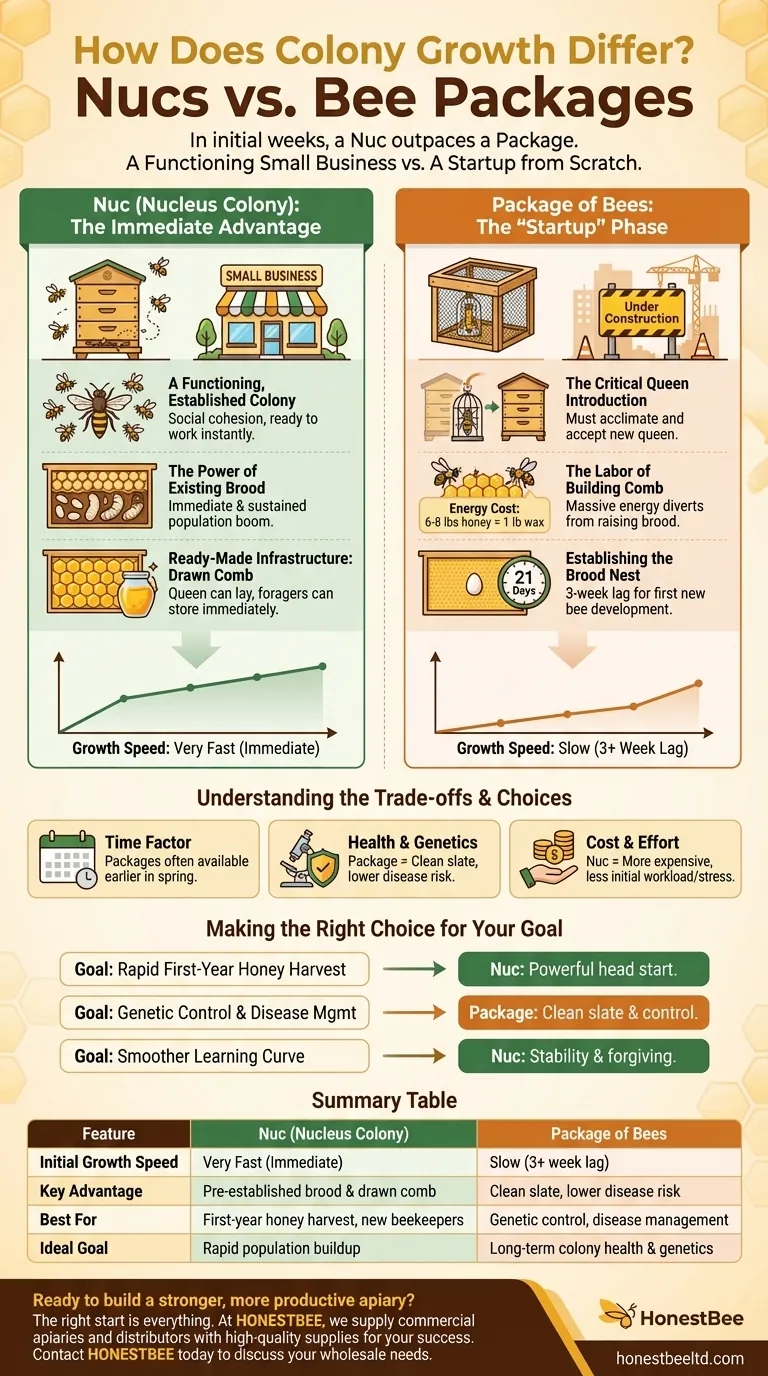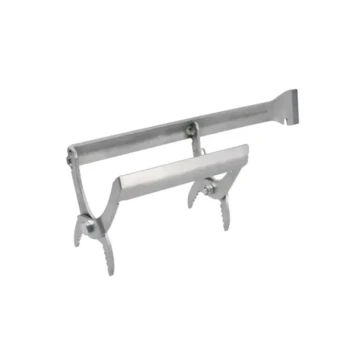In the initial weeks, a nucleus colony (nuc) will always outpace a package of bees in growth. A nuc is a pre-established, functioning hive with a laying queen, developing bees (brood), and drawn-out honeycomb. A package, in contrast, is a collection of unrelated bees with a caged queen that must build their entire colony infrastructure from nothing.
The core difference in growth comes down to a simple concept: a nuc is a functioning small business being relocated, while a package is a startup company hiring its CEO and building its office from scratch. The nuc has an immediate head start, but the package offers a clean slate.

Why Nucs Have an Immediate Growth Advantage
A nuc is, quite literally, a miniature, working colony. This gives it a powerful and immediate advantage in population expansion once it's installed in a full-sized hive.
A Functioning, Established Colony
A nuc isn't just a box of bees; it's a family unit. The bees are sisters, the queen is their mother, and the colony's roles—foragers, nurse bees, guard bees—are already established. This social cohesion allows them to get to work instantly.
The Power of Existing Brood
The most significant factor for rapid growth is the presence of brood in all stages: eggs, larvae, and pupae. This means thousands of new bees are scheduled to emerge within days and weeks of installation, creating an immediate and sustained population boom.
Ready-Made Infrastructure: Drawn Comb
The bees in a nuc have already invested the time and energy to build drawn honeycomb. The queen can continue laying eggs in these empty cells without delay, and foragers have a place to store incoming nectar and pollen immediately.
The Package Bee's "Startup" Phase
A package of bees begins with a significant deficit. Before any growth can happen, the bees must first complete several critical, time-consuming tasks.
The Critical Queen Introduction
The colony's first job is to accept the new queen. She arrives in a small cage, and the bees must slowly acclimate to her pheromones before releasing her. If they reject and kill her, the colony is set back weeks while you procure a replacement.
The Labor of Building Comb
If installed on frames with only foundation, the bees must consume enormous amounts of sugar syrup or nectar to produce wax. It is estimated that bees consume 6-8 pounds of honey to produce just one pound of wax. This is a massive energy cost that diverts resources away from raising brood.
Establishing the Brood Nest
Only after the queen is released and the workers have built new comb can she begin to lay eggs. It then takes 21 days for a new worker bee to develop from an egg to an adult. This built-in 3-week lag is the primary reason for a package's slower initial growth.
Understanding the Trade-offs
The nuc's faster growth does not automatically make it the superior choice. There are critical trade-offs to consider that relate to your specific goals and timeline.
The Time Factor: When Can You Get Your Bees?
Bee packages are often available several weeks earlier in the spring than nucs. This earlier start can give a package colony more time to build up over the entire season, potentially closing the initial gap with a later-installed nuc.
Health and Genetics
A package provides a clean slate. You are starting with fresh bees and a new queen on your own equipment, minimizing the risk of inheriting pests (like hive beetles) or diseases (like foulbrood spores) that can linger in the comb of a nuc.
Cost and Effort
A nuc is more expensive because you are paying for the bees, the brood, the drawn comb, and the food stores. However, for a new beekeeper, the stability and reduced initial workload of a nuc can make for a much less stressful and more successful first experience.
Making the Right Choice for Your Goal
Your decision should be based on your primary objective for the season.
- If your primary focus is rapid buildup for a first-year honey harvest: A nuc is your best choice, as its powerful head start is crucial for building a large foraging workforce quickly.
- If your primary focus is managing genetics and minimizing disease risk: A package provides a clean slate and more control, despite the slower initial growth.
- If you are a new beekeeper prioritizing a smoother learning curve: The stability and immediate activity of a nuc often make it the less stressful and more forgiving option.
Understanding these fundamental growth dynamics allows you to select the starting method that best aligns with your beekeeping objectives.
Summary Table:
| Feature | Nuc (Nucleus Colony) | Package of Bees |
|---|---|---|
| Initial Growth Speed | Very Fast (Immediate) | Slow (3+ week lag) |
| Key Advantage | Pre-established brood & drawn comb | Clean slate, lower disease risk |
| Best For | First-year honey harvest, new beekeepers | Genetic control, disease management |
| Ideal Goal | Rapid population buildup | Long-term colony health & genetics |
Ready to build a stronger, more productive apiary? The right start is everything. At HONESTBEE, we supply commercial apiaries and beekeeping equipment distributors with the high-quality supplies needed for success, whether you're starting with nucs or packages. Let our experts help you choose the right equipment for your growth strategy.
Contact HONESTBEE today to discuss your wholesale needs and ensure your colonies thrive.
Visual Guide

Related Products
- 4 Frame Plastic Nuc Boxes for Beekeeping Bee Nuc Box
- HONESTBEE Professional Long Handled Hive Tool with Precision Cutting Blade
- Professional Dual-End Stainless Steel Hive Tool for Beekeeping
- Multi-Function Plier-Style Frame Grip Hive Tool
- Professional Multi-Function Stainless Steel Hive Tool
People Also Ask
- What are nucleus colonies (nucs) and how do they compare to full-size Langstroth colonies?
- How does installing a nuc differ from installing a bee package? A Guide to Starting Your Hive Right
- What should a healthy brood nest in a nuc look like? A Guide to Strong Colony Development
- What are the advantages of choosing a nucleus hive over a package of bees? Get a Head Start with a Pre-Established Colony
- What are the benefits of maintaining a nuc in beekeeping? Gain Control and Resilience for Your Apiary



















